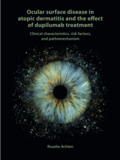Ocular surface disease in atopic dermatitis and the effect of dupilumab treatment
Clinical characteristics, risk factors, and pathomechanism

Achten, Roselie
- Promoter:
- Prof.dr. M.S. (Marjolein) de Bruin-Weller & prof.dr. J.H. (Joke) de Boer
- Co-promoter:
- Dr. M. (Marlies) de Graaf & dr. J.L. (Judith) Thijs
- Research group:
- Boer Kuiper
- Date:
- November 14, 2023
- Time:
- 16:15 h
Summary
This thesis discussed ocular surface disease (OSD) in patients with atopic dermatitis (AD) and the effect of dupilumab treatment. The clinical characteristics, risk factors and pathomechanism of OSD were investigated. It was found that 90% of patients with moderate-serious AD already had OSD, and that these patients had fewer conjunctival goblet cells compared with healthy controls. Also, we found higher biomarkers related to the severity of AD in the tear fluid of patients with moderate-to-severe OSD compared to patients with no or mild OSD.
During dupilumab treatment, the function of these goblet cells decreased. Eyelid eczema appeared to be associated with developing OSD both before and during dupilumab treatment. Also, we found that dupilumab reached the eye, as dupilumab was detectable in the tear fluid of dupilumab-treated AD patients. Examination of patients' tear fluid showed that patients with more severe OSD during dupilumab treatment had higher dupilumab tear fluid levels. Early treatment or adjustment of the dupilumab dosing interval may help improve these ocular abnormalities. A multidisciplinary approach to these ocular abnormalities involving both dermatologists and ophthalmologists is important to early diagnose and treat OSD.